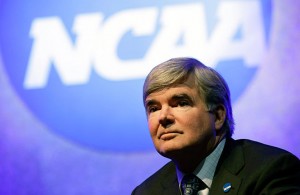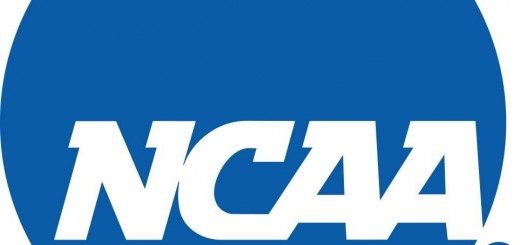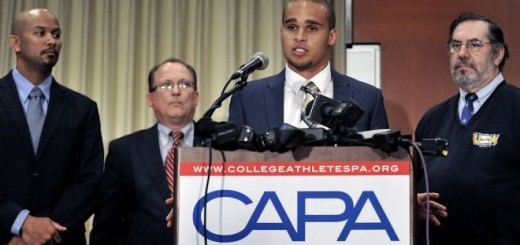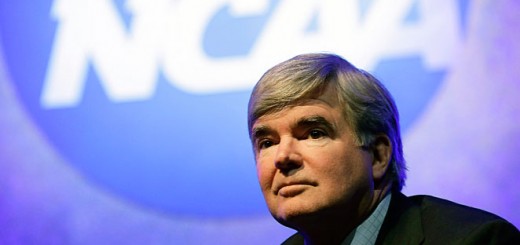Part One: NCAA Member Institutions: The Last Company Towns
-“Slavery Analogies should be used carefully. College athletes are not slaves. Yet to survey the scene – corporations and universities enriching themselves on the backs of uncompensated young men, whose status as “student-athletes” deprives them of the right to due process guaranteed by the Constitution – is to catch an unmistakable whiff of the plantation.” -Taylor Branch “The Shame of College Sports” The Atlantic
Mr. Branch would do well to take his own advice and reconsider what has become perhaps the most famous of his lines in his prominent article on the state of collegiate athletics today. In fact, if Mr. Branch was looking for an appropriate American historical comparison (rather than a sensational one), he needs to look no further than the “company town”. Company towns rose to prominence in the 1800s, reaching their peak around 1930 before falling out of favor by the end of World War Two. They were typically used for businesses in remote areas; for example logging camps or coal mining. The company would own everything in the town, from the store, to the town hall, to the business, to any local shopping. The company town also came with strict rules about curfew, trash, or other rules similar to what a HOA would use.
The core concept to the idea of a company town is known as “paternalism.” Paternalism is “the interference of a state or an individual with another person, against their will, and defended or motivated by a claim that the person interfered with will be better off or protected from harm.”[i] If you view this particular brand of corporate “governance” with the same skepticism and ire most focus towards the NCAA, there is a reason for it. The term “company town” became a pejorative due to working conditions, high profile strikes,[ii] and at least one famous country song.[iii] My grandfather was well aware of the problems with this type of life. He worked in West Virginia as a coal miner. He died of black lung when my father was 14. As it turns out there are worse consequences to “labor” than being forced to pass an economics test.
Company towns began to die out early in the 20th century due to an increase in affordable housing, and the proliferation of personal vehicles. In fact, the town of Scotia California, created as a company town in Northern California for the Pacific Lumber Co. and one of the last functioning company towns in America, was just recently dissolved starting in 2011. Residents there paint a much different picture of life, there are no homeless people, no trash on the streets, three bedroom homes for $900 per month, one resident stated “This is the best town there ever was.”[iv]
While there may not be company towns as the term was used at the turn of the 20th century in America, their influence is easily seen in the so called “corporate campus.” The SAS institute in Cary, North Carolina is a software firm “at the forefront of corporate paternalism” which has topped the Fortune 500 list of best companies to work for. Its corporate campus includes free medical care by on site staff doctors and nurses.[v]
Microsoft recently put together a self proclaimed “world’s largest corporate campus,” which includes a town square with shops to sell whatever you need as long as its not beer before 3pm. The “Googleplex” in Mountain View California offers dry cleaners, hairstylists, massage therapy and chefs to cook up to three meals per day. The employees may nap in “pods” during the day and shoot pool. While this all sounds well and good, one could argue that all of theses “perks” are designed to allow their employees to work long odd hours with as little interference from the outside world as possible.
The NCAA has essentially adopted a similar “paternalistic” (at least in name) model. The schools provide housing, meals, laundry services, and a variety of other services one may need in day to day life. Most students at the schools pay for all of this. However, for scholarship athletes, all or part of this is provided at no cost in exchange for the student’s participation in intercollegiate athletics. Participation in intercollegiate athletics is a decidedly better fate than laboring in a coal mine or a logging camp.
So, this begs the question: Where does the outrage derive from? Why are so many people in haste to tear down what they view as a “sham” or “exploitation”? Surely the conditions Merle Travis sung about aren’t present in intercollegiate sports? In fact, they aren’t. Student athletes on full scholarship graduate not owing a dime to the university. The outrage comes over the perceived notion that “someone” be it the NCAA or the universities are “getting rich” on the backs of “unpaid” labor, mostly the labor of young black men.
Part II: Show Me The Money! No really show me, the money! Wait, That’s It?
The media is quick to lead you to believe that Mark Emmert and his merry band of university presidents spend their nights swimming around in a pile of gold like Scrooge McDuck. Bill Maher tweeted during the NCAA Tournament, “March Madness really is a stirring remind of what America was founded up: making tons of money off the unpaid labor of black people” [sic][vi]. This misconception stems from a fatal flaw. People love to cite revenue numbers but fail to consider costs.
 This ignores half the equation.
This ignores half the equation.
So lets look at some real numbers, reported to and provided by the U.S. Department of Education and available for download here.[vii] All data is from the 2010-2011 season. The most profitable football program in the country that year was Texas, which made a 77 million dollar profit. This money, as it is at most schools is used to subsidize sports which do not make a profit for the school. Of 121 schools that played football that year, 41 did not make a profit. Only 43 schools made more than 10 million dollars per year on football. Schools like Florida State, West Virginia, Miami netted only around 7-12 million dollars.
This brings us to another critical point, is it right or fair, for schools to use profit from the football team to subsidize non-revenue sports instead of remitting the profits to the players, staff and others involved in generating it? While the issue is certainly debatable; I would argue yes.
For one thing, interest in sports does not grow in a vacuum. There is societal value in putting on women’s sports and smaller men’s sports. Nobody would debate the merits of a competitive athletics experience at the collegiate level, and opening this up to a wider range of students is a good thing. While I am not arguing that forcing schools to remit football profits to football players would end all other sports, I would argue that at most schools, the cost equation would change to an extent that the schools would seriously think about dropping those programs. Secondly, while the football players risk “life and limb” for the program, they are not the ones footing the bill and taking on the financial risk of operating a football/athletics program at a loss.
Looking at athletics department finances as a whole, Texas again leads the way with a 34 million dollar profit. However only 12 schools made a department wide athletics profit of over ten million that year, and only 22 made a profit of over five million that year. 54 FBS schools made no money on collegiate athletics that year. And in a small margin business a one million profit one year due to making a bowl game can easily be erased by a loss the following year if the team’s fortunes suffer. Collegiate athletics, as it turns out, is a financial proposition that is more appropriate for Mark Cuban on Shark Tank, than it is as an example of corporate greed or “fat cats” lining pockets.
So lets put this all in perspective. Off-shore oil rig workers, another “job” in which housing, food and other amenities are provided by the employer, can make anywhere from 50 thousand to well above 100 thousand dollars per year to work on an oil rig. In 2011, Chevron’s profits were 26.9 Billion. That my friends is big business, and coincidentally profits over 3000% larger than Texas football, the most profitable collegiate athletics team in the nation. So where is the outcry that Chevron remit this money to its labor?
The analogy isn’t a great one because Chevron is obviously a for profit corporation while the NCAA and educational institutions are not for profits. This does not mean it is a charity. The money derived from athletics gets used for a variety of purposes to fund other college athletics or educational programs. There is no University of Texas provost sitting in a high tower doing this and clicking refresh on his bank account every ten minutes.[viii] Yes Mark Emmert made 1.7 million last year. Yes, this is in line with the heads of other not for profit institutions.[ix] You’d have to pay me a hefty premium as well to take the beating that Emmert does. A little known fact is that most compliance officers at the NCAA earn only 30-60 thousand per year. The NCAA remits nearly all of the money it makes to its member schools for academic support of their student athletes[x]. In addition to that the NCAA has to finance championships in every sport other than FBS football, all of which costs significant amounts of money.
So what is the takeaway here? It’s not that there aren’t non-sequitors or things that need to change in the NCAA. Instances of Athletics Directors getting bonuses for a national title in an individual sport come to mind.[xi] Should student-athletes be able to profit off of their image? I don’t see a good reason why not.[xii] The point, is even the biggest schools aren’t profiting as much as most would like you to believe. And many schools aren’t profiting at all. Taylor Branch may catch an “unmistakable whiff of the plantation”, but all I can really smell in today’s environment is an unmistakable whiff of media sensationalism.
[i] http://plato.stanford.edu/entries/paternalism/
[ii] http://www.lib.niu.edu/1994/ihy941208.html - The Pullman strike occurred in the company town of Pullman Illinois and led to the United States Supreme Court Case Railroad Commission v. Pullman Co. The town was eventually dissolved by the Illinois Supreme Court which decided that the corporate purposes laid out in the company charter were not sufficient to support the Pullman Company’s town interests with regards to real estate and governance.
[iii] The song sixteen tons, recorded by Merle Travis and made famous by Ernie Ford sings “You load sixteen tons, what do you get; Another day older and deeper in debt; Saint Peter don’t you call me ‘cause I can’t go; I owe my soul to the company store”. Perhaps such a lyric is more appropriate for the throngs of law students graduating with debt, but that is a story for another day.
[iv] http://www.newsweek.com/last-company-town-68763
[v] http://www.newsweek.com/last-company-town-68763
[vii] http://www.star-telegram.com/2012/12/04/4460673/texas-football-leads-the-way-among.html?rh=1
[viii] Rather, the men and women who work in athletic departments and at the NCAA do so because they believe in helping young people and the positive influence of sports.
[ix] http://www.charitywatch.org/hottopics/Top25.html
[x] http://espn.go.com/college-sports/story/_/id/6756472/following-ncaa-money
[xii] Although there is an argument to be made that there would be no image to capitalize off of without the school provide a platform for the player to compete on.




Recent Comments